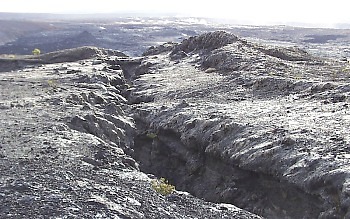fissure

Eruptive fissure on southeast rim of Kilauea caldera, Hawaii. This eruptive fissure was active briefly during an eruption in July 1974. Note prominent spatter ramparts on right, and subdued rampart on left, built by the ejection of lava along the fissure. The smooth texture of the surface on the lip of the fissure (lower right) is evidence that lava drained back into the fissure toward the end of the 1974 eruption. Credit: S. R. Brantley / US Geological Survey.
In geology, a fissure is a fracture or crack in rock along which there is a distinct separation; fissures are often filled with mineral-bearing materials. On volcanoes, a fissure is an elongate fracture or crack at the surface from which lava erupts. Fissure eruptions typically dwindle to a central vent after a period of hours or days. Occasionally, lava will flow back into the ground by pouring into a crack or an open eruptive fissure, a process called drainback; sometimes lava will flow back into the same fissure from which it erupted.


